How to Trim Monstera Plants? Essential Tips!
Trim your Monstera plant by using sharp, sterilized pruning shears for clean cuts. The best time is during its active growth in spring or summer.
Identify nodes at leaf junctions or where aerial roots emerge, and cut just below these nodes to promote healthy regrowth. Wear protective gloves and goggles to avoid sap irritation.
After trimming, water thoroughly, place it in bright, indirect sunlight, and maintain humidity at 60-80%. Regularly monitor soil moisture and use a balanced water-soluble fertilizer.
Proper trimming will encourage vibrant growth, better air circulation, and a more aesthetically pleasing plant. Explore further for detailed guidance.
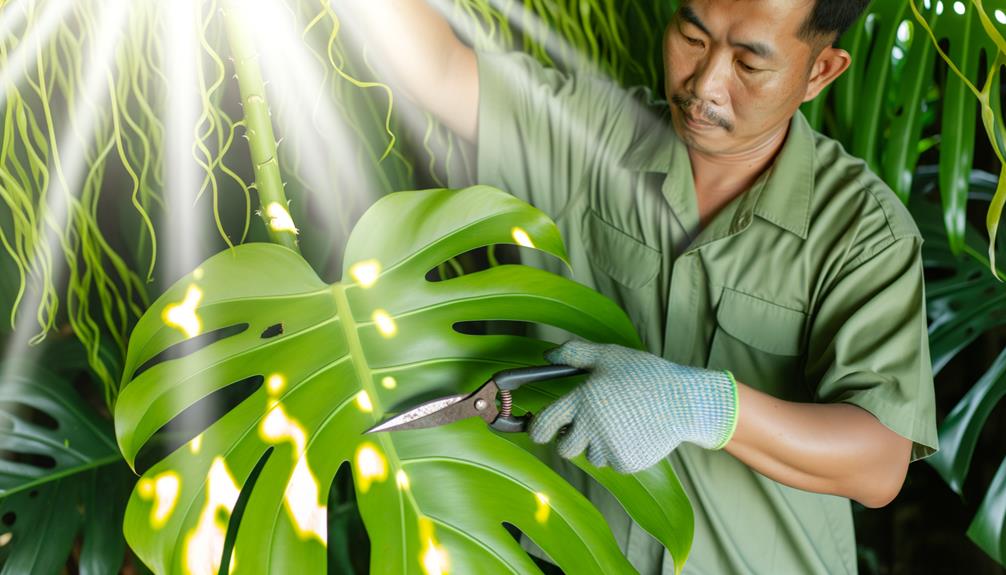
Key Takeaways
- Trim Monstera plants during late spring or early summer to avoid stressing the plant in dormant periods.
- Use sharp, sterilized pruning shears to make clean cuts near nodes for healthy regrowth.
- Position the plant in bright, indirect light and maintain humidity levels of 60-80% post-trimming.
- Guide aerial roots into soil or support structures, securing them to moss poles or trellises if needed.
- Regular trimming prevents disease, promotes healthy growth, and maintains aesthetically pleasing appearance.
Understanding Monstera Growth
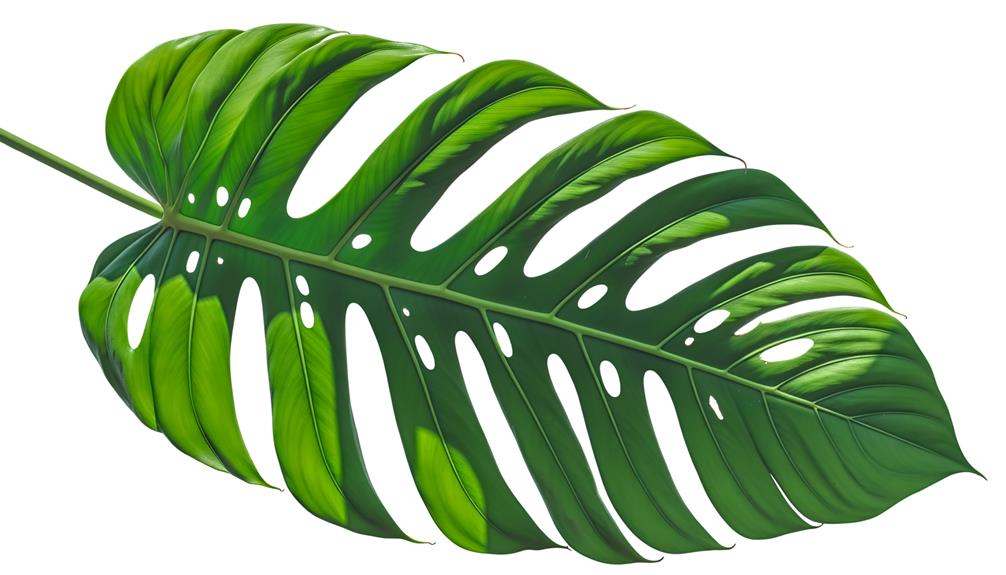
Monstera plants, scientifically known as Monstera deliciosa, frequently exhibit unique growth patterns characterized by their iconic split leaves and aerial roots. These splits, or fenestrations, increase leaf surface area, optimizing light absorption. You’ll notice that younger leaves are solid, with fenestrations developing as the plant matures.
Aerial roots emerge from nodes along the stems, aiding in nutrient absorption and anchorage. Understanding these growth mechanisms is essential for effective trimming. Monitor the plant’s growth, noting the direction and elongation of stems. Trim near nodes without damaging them to promote healthy regrowth.
Recognize that pruning not only controls size but encourages bushier, more aesthetically pleasing growth. Remember, precise cuts reduce plant stress and enhance overall health.
Tools You Will Need
You’ll need specific tools to guarantee precise cuts and plant health. Essential pruning tools include:
- Sharp pruning shears
- Sterilizing alcohol
- Clean gloves
Always wear safety gear like:
- Protective eyewear
- Gloves to prevent injuries and contamination.
Essential Pruning Tools
To effectively prune your Monstera plant, you need to gather a set of essential tools, including sharp pruning shears, sterilizing solution, and protective gloves.
First, make sure your pruning shears are sharp to make clean cuts, reducing the risk of plant damage and disease.
Use a sterilizing solution, such as isopropyl alcohol or a bleach mixture (1 part bleach to 9 parts water), to disinfect the shears before and after each cut, preventing pathogen transmission.
Protective gloves shield your hands from potential irritants and provide a better grip.
Proper tools and maintenance guarantee precise pruning and promote healthy growth. Remember, effective pruning starts with the right tools and meticulous preparation.
Safety Gear Essentials
When trimming Monstera plants, wearing safety gear such as protective gloves, safety goggles, and a long-sleeved shirt is important to prevent injuries and protect against plant sap irritants.
The gloves should be made from nitrile or latex to guarantee impermeability to sap, which can cause skin irritation. Safety goggles are vital to shield your eyes from accidental sap splashes, which may cause discomfort or injury.
A long-sleeved shirt provides an additional barrier, minimizing skin contact with potentially irritating plant material. Make sure the shirt is tightly woven and covers your arms fully.
When to Trim?

You’ll want to trim your Monstera during its active growing seasons, typically spring and summer, to encourage healthy growth. Monitor the plant for new growth indicators such as fresh leaves and stems, which signal the best time for pruning.
Avoid trimming in the dormant winter months as this can stress the plant.
Optimal Trimming Seasons
Monstera plants thrive best when trimmed during their active growth period in late spring to early summer, ensuring minimal stress and best recovery. During this time, the plant’s metabolism is at its peak, allowing for efficient wound healing and robust regrowth. Avoid trimming in fall and winter when the plant’s growth rate slows, as this can lead to prolonged recovery times and potential infection.
| Season | Growth Stage | Recommended Action |
|---|---|---|
| Late Spring | Active Growth | Ideal Trimming Period |
| Early Summer | Peak Metabolism | Superior Recovery |
| Fall/Winter | Dormant/Slow Growth | Avoid Trimming |
New Growth Indicators
Identifying new growth indicators is crucial in determining the best time to trim your Monstera plant. Look for signs like fresh, light-green leaves unfurling, which indicate active growth.
Check for aerial roots emerging from nodes, as these show the plant’s readiness to expand.
Observe the presence of new leaf buds forming at stem tips; this indicates vigorous growth phases.
Trim only during these periods to minimize stress and promote faster recovery. Make sure your tools are sterilized to prevent infection.
Cut just above a node, focusing on leggy or overcrowded sections to enhance airflow and light penetration. Monitoring these indicators helps you maintain a healthy, thriving Monstera, optimizing both aesthetic appeal and plant health.
Identifying Nodes
When identifying nodes on your Monstera plant, look for the small, raised bumps along the stem where leaves and aerial roots emerge. These nodes are vital for the plant’s growth and propagation.
To accurately identify nodes, follow these steps:
- Inspect the Stem: Carefully examine the stem for any protrusions or swellings. Nodes appear as distinct, raised points.
- Observe Leaf Junctions: Nodes are typically located at the junctions where leaves attach to the stem. This is where new growth will most likely occur.
- Check for Aerial Roots: Nodes often produce aerial roots. If you see small roots emerging, you’ve likely found a node.
Understanding nodes is essential for effective pruning and propagation, ensuring your Monstera thrives.
Cutting Techniques
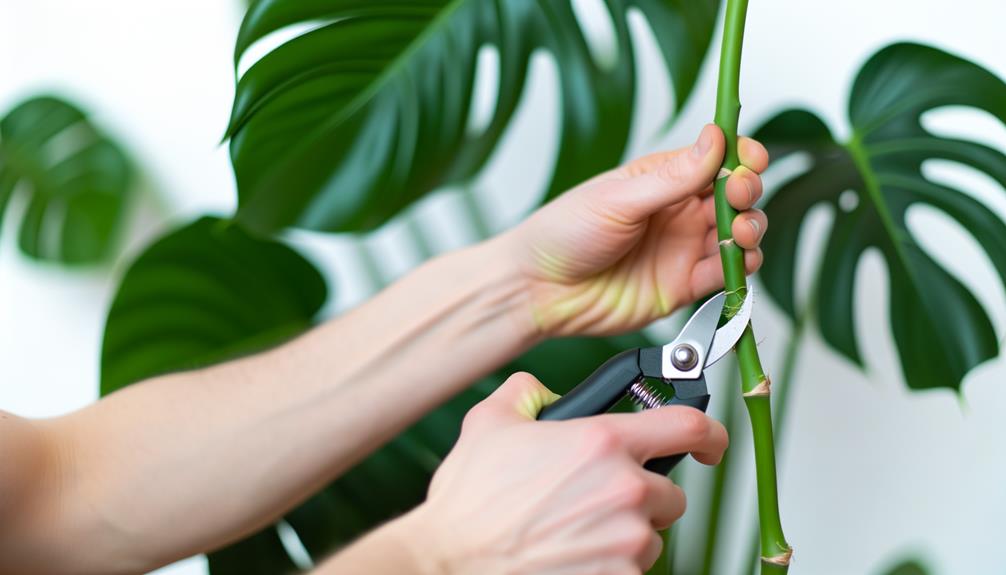
To properly prune your Monstera, use sterilized, sharp scissors or pruning shears to make clean cuts just above the identified nodes. Make sure your tools are disinfected with isopropyl alcohol to prevent pathogen transmission.
When cutting, angle your shears at 45 degrees to facilitate best healing and reduce water retention at the cut site. Target mature, yellowing leaves first, as they divert energy from the plant’s growth. Trim aerial roots sparingly, focusing on those that are excessively long or damaged.
Always make your cuts in one swift motion to avoid crushing the plant tissue. After trimming, monitor the plant for signs of stress or infection, and adjust watering routines to support recovery.
Follow these techniques to maintain your Monstera’s health.
Pruning for Size Control
Having mastered cutting techniques, let’s now focus on using strategic pruning methods to control your Monstera’s size and shape effectively.
Begin by identifying overgrown or unruly stems. Pruning will help maintain a manageable size and encourage a more aesthetically pleasing form.
Follow these steps:
- Select the Pruning Point: Choose a node where you want the plant to stop growing. Cut just above the node to direct energy elsewhere.
- Sterilize Tools: Use isopropyl alcohol to clean your pruning shears, preventing the spread of pathogens.
- Angle Your Cuts: Make diagonal cuts to facilitate quick healing and reduce water retention on cut surfaces.
Encouraging New Growth
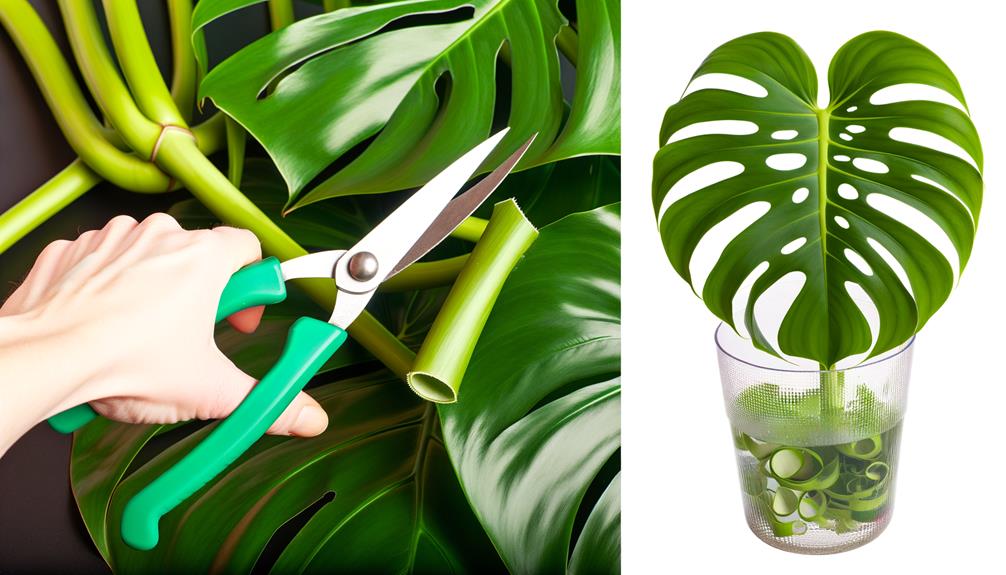
To promote new growth in your Monstera, you should focus on pruning for vitality by removing any yellow or damaged leaves.
Stimulate leaf development by making precise cuts just above a node, where new leaves naturally emerge.
Mastering node cutting techniques will guarantee you maximize the plant’s regenerative capabilities.
Pruning for Vitality
Pruning Monstera plants involves strategically cutting stems and leaves to stimulate robust new growth and maintain plant health.
To achieve prime vitality, you must focus on three essential steps:
- Identify and Remove Dead or Damaged Leaves: Carefully inspect your Monstera for any yellowing or brown leaves. These are expired tissue and should be pruned to prevent disease spread.
- Cut Above a Node: Locate the nodes, where leaves and aerial roots emerge. Make clean cuts just above these nodes to encourage fresh growth while minimizing shock to the plant.
- Thin Out Crowded Areas: Guarantee adequate light and air circulation by selectively pruning dense sections. This reduces competition for resources and fosters healthy development.
Utilize sterilized pruning tools to prevent infection, securing your Monstera thrives.
Stimulating Leaf Development
Stimulate new leaf development in your Monstera by ensuring ideal light conditions and proper nutrient supply. Place your plant in bright, indirect light to maximize photosynthesis without causing leaf burn.
Apply a balanced, water-soluble fertilizer every 4-6 weeks during the growing season. Monitor and adjust humidity levels to stay between 60-80% to mimic natural tropical environments. Ensure your Monstera gets adequate water but avoid waterlogging to prevent root rot.
| Aspect | Details |
|---|---|
| Light | Bright, indirect light |
| Fertilizer | Balanced, water-soluble, every 4-6 weeks |
| Humidity | 60-80%, mimic tropical conditions |
| Watering | Adequate water, avoid waterlogging |
Handling Aerial Roots
To manage the aerial roots of your Monstera plant, gently guide them into the soil or a nearby support structure to encourage proper growth and stability. Begin by inspecting the roots for any signs of damage or disease. Using clean, sharp pruning shears, trim any unhealthy sections.
Position the healthy aerial roots towards the soil, gently pressing them in to promote nutrient absorption. Alternatively, you can secure the roots to a moss pole or trellis using plant ties. This will mimic their natural climbing behavior.
Confirm the support structure is stable and moist to facilitate root attachment. Regularly check the roots to make sure they’re integrating well into the new environment, adjusting ties as needed to prevent constriction.
Dealing With Pests
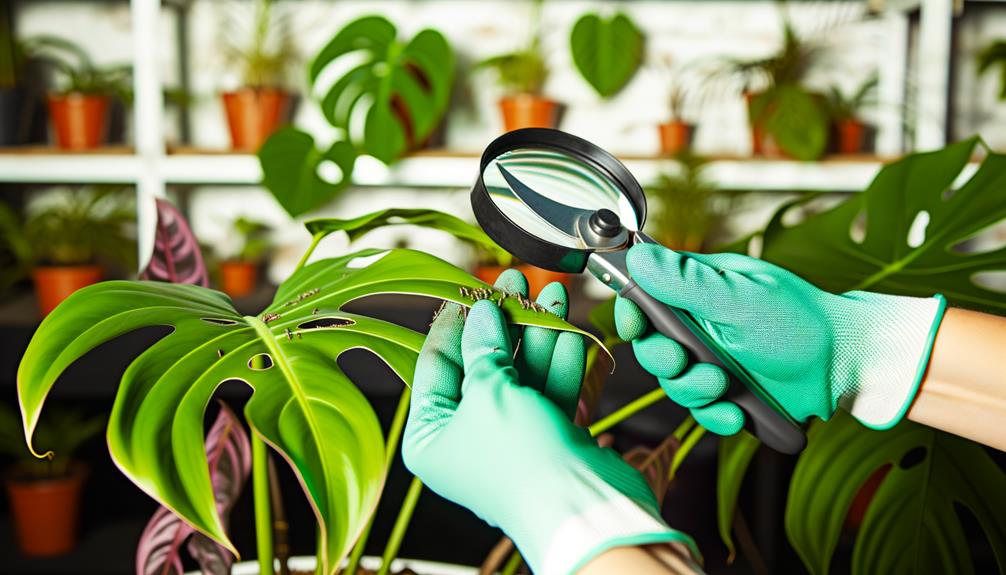
While ensuring the proper development of aerial roots, it’s equally important to monitor your Monstera for common pests like spider mites, mealybugs, and scale insects. These pests can harm your plant to a large extent if not managed promptly. Use a magnifying glass to inspect the undersides of the leaves and stems.
To effectively deal with pests, follow these steps:
- Identify the Pests: Recognize the signs of infestation, such as webbing (spider mites), cotton-like masses (mealybugs), and small bumps (scale insects).
- Isolate the Plant: Immediately separate the affected Monstera to prevent the pests from spreading to other plants.
- Apply Treatments: Use insecticidal soap or neem oil to treat the infestations. Ensure thorough coverage on all plant parts, especially the undersides of leaves.
Post-Trimming Care
After you’ve finished trimming your Monstera, promptly water the plant thoroughly to aid it in recovering from the stress. Make sure the soil is evenly moist but not waterlogged.
Position the Monstera in a spot with indirect sunlight to prevent additional stress from direct rays. Sustain a humidity level of about 60-70% by misting the leaves or using a humidifier.
Regularly monitor soil moisture; water when the top inch feels dry. Utilize a balanced, water-soluble fertilizer at half strength every 4-6 weeks to bolster new growth.
Inspect for signs of infection or pests, as the plant may be more prone post-trimming. Pruning wounds should heal within a few days, fostering healthy, robust growth.
Common Mistakes
Many gardeners make the mistake of using dull pruning tools, which can cause jagged cuts and increase the risk of infection. Ensuring your tools are sharp and sterilized is essential for the plant’s health.
Additionally, avoid trimming too much at once; this can stress the plant and inhibit growth.
Consider these common mistakes:
- Over-Trimming: Remove no more than 25% of the plant’s foliage at a time to prevent shock.
- Incorrect Timing: Trim during the plant’s active growing season, typically spring and summer, for best recovery.
- Ignoring Sanitation: Always sterilize your pruning shears with isopropyl alcohol before and after each cut to prevent the spread of pathogens.
Benefits of Regular Trimming
Regularly trimming your Monstera plants encourages healthier growth, prevents disease, and promotes a more aesthetically pleasing appearance. By removing dead or yellowing leaves, you allow the plant to allocate resources more efficiently, enhancing photosynthesis and nutrient uptake.
Pruning also improves airflow around the foliage, reducing the risk of fungal infections and pest infestations. To achieve peak results, use sterilized, sharp pruning shears and make clean cuts just above a leaf node or stem junction. This encourages new growth and helps maintain the plant’s structural integrity.
Additionally, trimming helps control the size and shape of your Monstera, ensuring it remains manageable and visually appealing in your indoor space. Regular maintenance is key to a thriving Monstera.
Conclusion
To sum up, mastering the art of pruning your Monstera isn’t simply plant care—it’s a botanical revolution! By utilizing the correct tools and techniques, you’ll elevate your Monstera to be admired by every plant lover.
Keep in mind, timing and accuracy are crucial; you’re not just trimming, you’re crafting a green masterpiece. So, immerse yourself, conquer those nodes, and witness your Monstera flourish like never before.
Your plant will express gratitude by thriving beyond your imagination!






